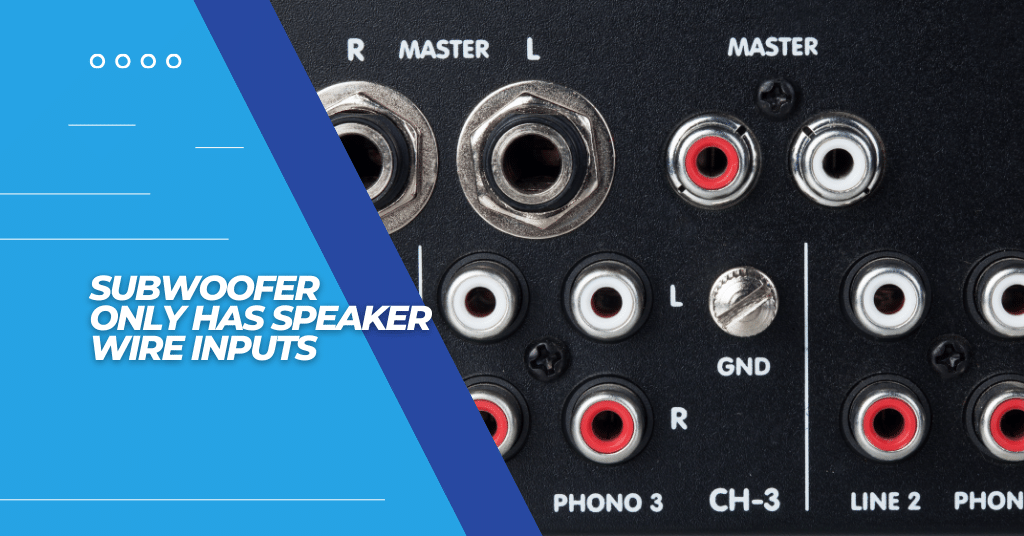Subwoofer Only Has Speaker Wire Inputs

Most of the subwoofers come with only speaker wire inputs. Therefore, I have seen many people getting confused about how to connect them with receivers.
You can easily connect the subwoofer with only speaker wire inputs directly to an amplifier or receiver using speaker cables. You may find this setup in older or budget-friendly models. During connection, you just have to ensure proper polarity (match positive to positive and negative to negative terminals) between the subwoofer and amplifier. As a result, This direct connection method can offer a clear signal path.
What Are Speaker Wire Inputs?
Speaker wire inputs are integral components of audio devices, including subwoofers, serving as the connection point for raw speaker cables.
These inputs typically feature two terminals, either spring-loaded clips or screws, designated for the positive (+) and negative (-) wires.
Unlike connectors like RCA or optical, they facilitate a direct electrical link between an amplifier or receiver and a speaker. Speaker wire inputs utilize the bare ends of speaker cables, offering an unobstructed pathway for the audio signal.
How to Connect a Subwoofer That Only Has Speaker Wire Inputs?
Here are the simple steps that will enable you to make a successful connection between the subwoofer and amplifier/receiver using speaker-level inputs:
1. Identifying the Speaker Wires:
Before making the connection, you must identify the required speaker wires (color codes, textures, and wire gauges) for your audio setup.
Firstly, you’ll have to look for colors on the cables. Ideally, the red wire symbolizes positive (+), and black signifies negative (-). However, if your speaker wires aren’t color-coded, you can identify them by feeling the texture.
A wire with ridges or writing is usually the positive end. The next thing to identify is the wire gauge. The thickness of the wire is inversely proportional to the gauge number.
Thicker wires have lower gauge numbers and are better for longer runs as they ensure minimal signal loss.
2. Strip the Speaker Wire Cables:
After identifying the correct speaker cable, you’ll have to strip it at both ends. You can simply follow the below steps:
- Choose the Right Stripping Tool: Get a suitable wire stripper that can cleanly strip the gauge of your speaker wire. However, you may also use a needle-nose or utility knife if you don’t have a cable stripper on the spot.
- Measure the Length: Before starting the wire stripping process, you’ll have to understand how much insulation you need to remove—typically about 1/2 inch (1.27 cm) from the end.
- Place the Wire: Now, simply insert the wire into the correct gauge slot on the stripper, aligning it with your measured length.
- Apply Some Pressure and Strip: After inserting, you’ll just have to squeeze the stripper’s handles together, firmly applying pressure on the wire’s insulation. Then, pull the stripper towards the wire’s end while maintaining this pressure, removing the insulation.
3. Connecting Subwoofer to the Receiver/Amplifier:
Now, it’s time to connect your subwoofer to the receiver or amplifier subwoofer output terminals. Before connection, you’ll have to locate the speaker-level inputs on your subwoofer and speaker output terminals on your amplifier or receiver. On your amplifier or receiver, they may also be labeled (e.g., “Front L”, “Front R”, “Rear L”, “Rear R”).
After locating speaker terminals on both sides, connect one end of the red wire with subwoofer positive speaker terminal and other end of the red wire to the amplifier/receiver or positive terminal and connect one end of the black wire to the subwoofer’s negative speaker input and other end of the black wire to amplifier/receiver negative terminal.
Press down on the spring-loaded clips to insert and then release to secure the wire.
Common Mistakes and How to Avoid Them:
If your subwoofer is still unable to produce sound or produces low sound quality after connecting it with the amp using speaker inputs and speaker outputs, you might have made some mistakes. Usually, people make the following mistakes:
1. Reversed Polarity:
Most of the time, people fail to determine the correct polarity, resulting in a reversed polarity connection. Reversed polarity happens when an audiophile connects the positive (+) terminal of the subwoofer inadvertently connects to the negative (-) terminal of the amplifier and vice versa.
This error can lead to a peculiar phenomenon called “phase cancellation.” In simple terms, phase cancellation happens when specific audio frequencies produced by the subwoofer and the amplifier negate each other.
This counteraction results in distorted or weak sound output, adversely affecting the audio experience. However, you can simply avoid this mistake by aligning the amplifier’s positive terminal with the subwoofer’s positive terminal and, similarly, connecting the negative terminal to the negative.
2. Using Mismatched Wire Gauges:
Another common mistake that you might need to consider is using mismatched wire gauges. Some individuals might use different wire gauges for different speakers or connections.
An incompatible gauge connection happens when wire gauges present varying resistance levels, leading to disparities in sound levels and quality.
This inconsistency can significantly impact the listening experience. To resolve this problem, you should use the same gauge size for all speakers and connections to ensure an even resistance level, thus maintaining a steady sound quality and volume. It’s not that hard to choose the correct size gauge wire for the subwoofer.
3. Over-stripping Speaker Wires:
Over-stripping speaker wires is a prevalent mistake that could lead to issues such as short circuits and unwanted interference due to the exposure of more wires than necessary.
This happens when too much insulation is removed from the wire’s end. To avoid this issue, it is crucial to strip only about half an inch or as per the manufacturer’s recommendation of insulation from the wire’s end.
4. Poor Quality Connections:
Suppose the speaker wires are loosely connected or not adequately secured into the speaker input terminals. Such faulty connections can lead to intermittent sound, static, or sudden loss of audio, disrupting your listening experience.
Therefore, it’s critical to double-check that all your connections are secure. If your terminals are equipped with screws, ensure they are tightened adequately.
Remember, a good audio system is only as strong as its weakest link, and in this context, it could be as simple as a loose connection.
5. Ignoring Wire Length:
Avoid using excessively long speaker wires when a shorter one will serve the purpose; otherwise, it can also be a mistake.
I have seen many individuals who may not realize that exceedingly long wires can introduce additional resistance, negatively impacting sound quality.
The added resistance can decrease the power supplied to the speakers, leading to a subdued and less vibrant sound output.
However, you must also ensure that the short length does not strain the connection or cause any physical damage to the equipment.
Therefore, you should aim for a balance between convenience and performance while setting up your sound system.
On a related note, a subwoofer cable can typically be as long as 15 meters without significant loss of signal quality.
General FAQs
Why Does My Subwoofer Only Have Speaker Wire Inputs?
Subwoofers only having speaker wire inputs are typically seen in home theater systems. This design allows the amplifiers in the main speakers to handle the power needs of the subwoofer. It simplifies connections and reduces the need for an additional amplifier.
Can I Convert Speaker Wire Inputs to Other Connection Types?
Yes, appropriate adapters can convert speaker wire inputs to other connection types. For instance, banana plugs, pin plugs, or spade connectors could be used. These adapters connect speaker wires to various audio devices, enhancing their versatility and usability.
Will Using Speaker Wire Connections Limit My Sound Quality?
It’s essential to understand that while speaker wires are critical, they aren’t the most influential factor in sound quality. The type of wire, its length, and how it’s installed can impact sound fidelity. However, the limiting effect is often negligible unless you use extremely high-quality audio equipment or long cable runs.
